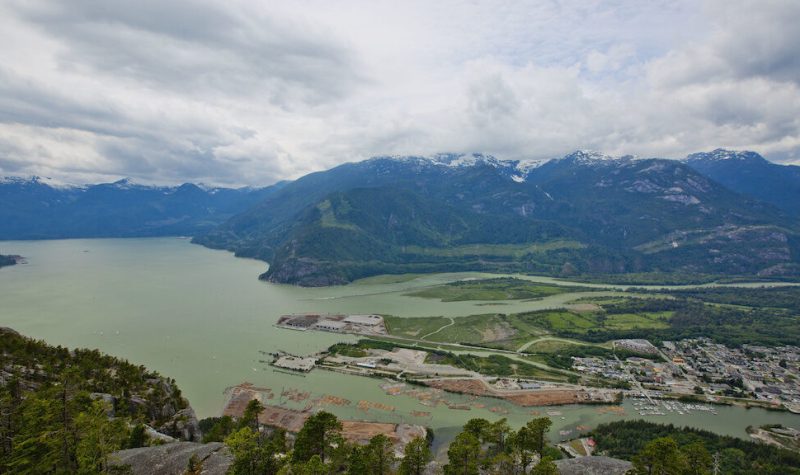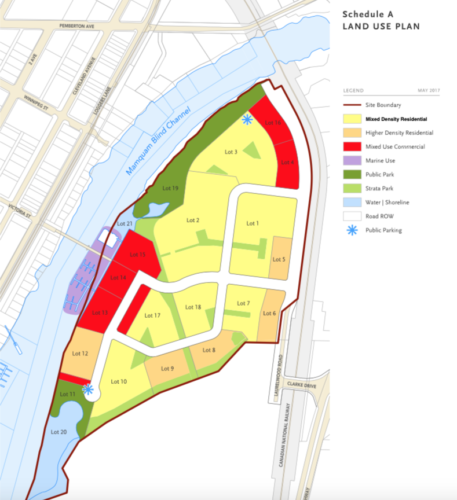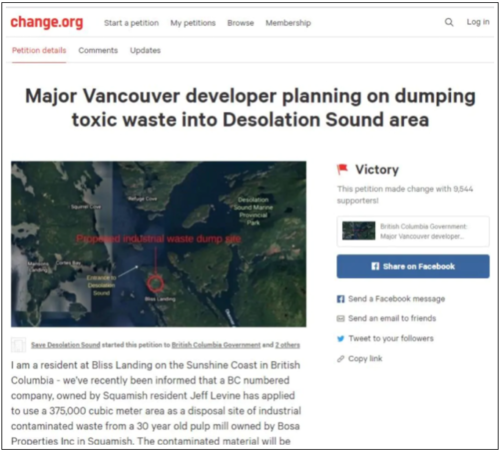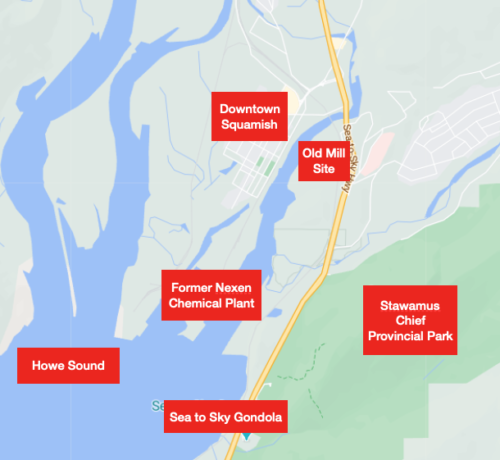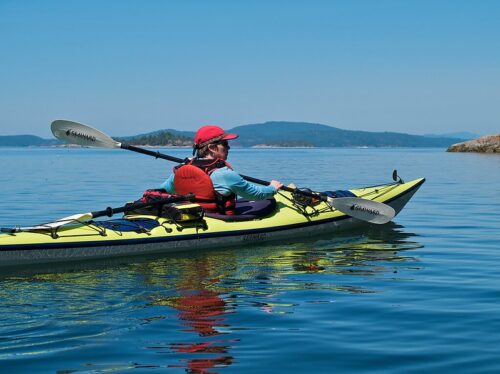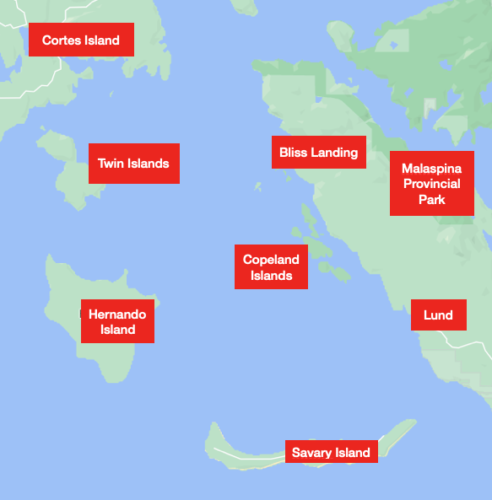By Roy L Hales
There have been new revelations about Jeff Levine and the proposed Bliss Landing wood waste landfill project.
Withdrawing the proposal
Levine withdrew his proposal on December 15th and a Ministry of Environment spokesperson informed the quathet Regional District the same day.
“People have threatened me, verbally abused me, threatened my family. It’s not worth it, it’s absolutely not worth it. And it’s all because this person called it toxic waste — and it’s not,” he told CBC news.
Levine added, “If you don’t agree with the industrialization of an area, that’s one thing to disagree with, but don’t try to turn someone into [an] environmental monster that’s going to dump hazardous waste on land and ocean and negatively affect people, because those are two different things…. I was guided by the Ministry of Environment by this process, and I followed the process.”
Variations of Levine’s story appeared in Cortes Currents, The Squamish Chief, and Powell River Peak.
He claims to have already lost $400,000 through the venture.
Not a Vancouver developer
Much of the opposition came through a Change.org petition called “Major Vancouver developer planning on dumping toxic waste into Desolation Sound.”
The ‘developer’ in question was not Levine, but rather a Vancouver based company which he hoped would use his services. Levine has repeatedly said he does not have a contract with Bosa Properties, owners of the old Interfor mill site, and will also be seeking wood waste from sites throughout the Fraser Valley.
The Squamish Chief reported that District of Squamish staff informed them that, “the District is not banning wood waste from being disposed of in town, but determined in 2017 that municipal land would no longer be leased for wood waste disposal, and that wood waste landfill on District property will be phased out by 2022.
As a result, Levine created a company and offered up land that he bought in Desolation Sound as a dumping spot for local businesses seeking to get rid of their wood waste.
He said he was hoping to attract the business of the SEAandSKY Bosa-Kingswood project on the Waterfront, which has been looking for a contractor to take the wood waste, as the area was previously the old Interfor mill site.
However, Levine hadn’t signed a deal with the company, as the province had yet to approve his project.”
A spokesperson for Bosa Properties confirmed that no contract has been signed.
The report which Vancouver based Keystone Environmetal prepared for Levine states, “The material to be landfilled will originate from several wood processing locations such as sawmills, dry land sorts and former sawmills where the saw dust, wood chips and bark was previously buried.”
Change.org petition taken down
The Change.org petition against a Major Vancouver developer dumping toxic waste into Desolation Sound was taken down, but not before it 9,544 people signed.
No one has explained how the petitioners came to use the name Save Desolation Sound’s name without the express permission of that organization’s board of Directors.
Though the petition clearly states it was started by Save Desolation Sound, the environmental group denies any connection, adding “It was initiated without any consultation with the SDS.”
According to CBC News, “on Dec. 16, a Change.Org spokesperson told CBC in an email: ‘The petition was started by a small group of local residents and I’ve just learned that they are no longer comfortable speaking to the media.’ The petition was taken down the same day “at the request of the petition starter …’”
Toluene is present
The Change.org petition stated, “We’ve been able to access reports on the waste materials that indicate high levels (up to 100X higher than legal limit) of a chemical called Toluene, which is highly toxic. Exposure during pregnancy can result in birth defects.”
The post lists a number of other “hazardous contaminants” and states “These contaminants were found in waste samples at levels ranging from 100% to 3,000% of the safety limits …”
A Ministry of the Environment spokesperson emailed Cortes Currents that “According to the application received by the Ministry, the source of the material was from the old mill site in Squamish. The proponent is required to fully characterize the waste before it can be moved however it appears to be primarily wood waste. Preliminary information received by the ministry indicated that the toluene is biogenic in nature, meaning it is a natural byproduct of wood decomposition and not from a petroleum product.”
The Keystone report states there is toluene in the Squamish site, but the chemical markers indicating a petroleum origin are not present.
“The laboratory analysis and evaluation concluded that the toluene in the stockpile is biogenic.”
Other chemical pollutants
According to the Lund Community Society, “The wood waste materials are coming from a site in Squamish that is notorious for contamination from industrial activity, including a nearby mine.”
In their description of the proposed development at Waterfront Landing park, the District of Squamish states, “previous industrial use has led to some site contamination.”
In 2019, Municipal environmental co-ordinator Caroline Ashekian informed the Squamish council that “the waste [in Waterfront Landing] wouldn’t contaminate the area, but it could result in structural instability.”
Proposed Bliss Landing wood waste landfill
Keystone states that the Bliss Landing site would use:
“wood waste that originates from the wood processing industry and have not been treated with glue, paint, or preservatives. The proposed waste may include bark, branches, broken logs, hog fuel, mill ends, wood chips, shavings and saw dust. The proposed waste will only be accepted at the Proposed Landfill with sufficient evidence that the concentration of contaminant of concern are less than the Contaminated Site Regulation (CSR) standard for Industrial Lands (IL), including consideration for:
- Human intake of contaminated material
- Groundwater used for drinking water
- Toxicity to soil invertebrates and plants
- Groundwater flow to surface water used by freshwater and marine aquatic life
200,000 m3 of material
This report also mentions a reduction in the amount of material to be received. Levine’s Environmental Protection notice stated this will be 375,000 m3 over a 15-month period. Keystone adds that, “The landfill authorization was modified several weeks ago to only authorize receipt up to 200,000 m3 of material at the Site.”
From the Public Record
Jeff Levine has a relationship with the old Squamish mill site’s Vancouver based Developer.
The Squamish Chief identified Levine as ”a contractor for Bosa Properties” in a 2018 article about the removal of a half sunken sailboat from Mamquam Blind Channel.
A year later, Levine was called “a Bosa Properties consultant” in a report about the proposed pedestrian crossing over the channel.
He has also been “a spokesperson” for a proposed basalt mine owned by a totally different company.
In fact, the Squamish Chief has mentioned Levine in at least 22 articles since 2009. A large number of these deal with the Sea to Sky Adventure Company, which he owns, but Levine also spoke about development of the downtown core and Waterfront Landing, a proposed Squamish Gas project and the Sea to Sky Gondola Project.
Levine is also mentioned in the Squamish Reporter and his name appears in the minutes of the District of Squamish Council in nine separate occasions.
Notifying the Public
There have been some complaints about Levine not giving adequate notification for the proposed wood waste landfill. According to the Lund Community Society website, “There has been none or very limited public consultation on this project.” A Bliss Landing resident, who declined to comment on record, emailed Cortes Currents that he was not aware of Levine contacting anyone in the neighbourhood. Though the project is in quathet Electoral Area B, director Mark Gisborne said the first notification he had of the project was when someone asked him about it through Facebook messenger.
Cortes Regional Director Noba Anderson said that Levine does not have to contact individual directors, just the Regional District. She added that, though the Bliss Landing area is within sight of Cortes, she has no jurisdiction over what happens there.
A Ministry of Environment spokesperson informed Cortes Currents that it was Levine’s responsibility to notify the public, but “a consultation report is required as part of the final application to the ministry.”
The spokesperson directed me to a webpage where it states that, in addition to notifying the regional district, the applicant must:
- post “a completed copy of the appropriate Environmental Protection Notice (New Application or Significant Amendment), on-site; and
- publish “the Notice, once in a local newspaper serving the area where the discharge is proposed and once in the British Columbia Gazette Part I. This provides the public with a 30- day period in which to provide comments.”
Environmental Concerns on land
The Lund Community Society is concerned that, “Most of the site’s surface water would likely drain north into Hinder lake, through Malaspina Provincial Park, across the Sunshine Coast trail, into Okeover Inlet and, finally, into Desolation Sound Marine Park. Any ground water that leaches into the ground would only be a few hundred meters north and above the community water wells and aquifers.”
They are also concerned about the close proximity of an industrial landfill would be built near existing parks and recreational trails.
Keystone Environmental responded to much of this in their site report:
“The nearest drinking water well is located approximately 860 m south of the Site. The well is located up-gradient to the Proposed Landfill, opposite to where groundwater would flow. Therefore, water from the site will not travel to the drinking water well location.”
“Children and other recreational users are not expected to be present at the Proposed Landfill. The Proposed Landfill will be located within a private property with a 50 m setback from the property boundary, and 250 m from Sarah Point Road. The Site has been vacant for over 30 years and the entire Site was clear-cut logged in the 90s.”
Keystone has a long history of offering solutions to environmental problems and has a list of proactive measures for Levine to follow:
- Groundwater monitoring around the landfill to confirm that the water quality does not change over time.
- Enclosing the deposited material. The wood waste will be deposited on a low permeability soil liner to prevent potential releases and will be covered with a low permeability cover and soil cover that will shed precipitation and prevent contact with the deposited material.
- A soil cover will be placed over the landfill and vegetated to prevent erosion of surface soils from the deposit location. Surface water flow will not be permitted to flow over the slopes in a manner likely to cause erosion and gullying of the steep slopes.
- Water will not be permitted to pond and infiltrate into active or completed landfill areas, but will be diverted from contact with the wood waste and directed through ditches and drains to the on-site wetland.
Marine concerns
The Lund Community Society is also concerned about barges sailing too close to the Copeland Islands Marine Provincial Park or having an adverse effect on existing oyster farms.
Keystone Environmental responded, “The marine aquatic environment is located greater than 500 m from the site. The CSR defines that the aquatic receptors located greater than 500 m away are considered to be low risk and do not require these receptors to be evaluated. The soil quality results were compared to aquatic life standards and were less than numerical standards protective of aquatic life, therefore indicating that there is not a risk to the aquatic environment.”


